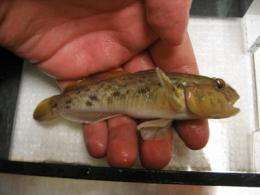Round Goby invade Great Lakes

Canadian scientists uncover alarming invasion of round goby into Great Lakes tributaries: impact on endangered fishes likely to be serious.
A team of scientists from the University of Toronto, the Ontario Ministry of Natural Resources and the University of Guelph has identified a drastic invasion of round goby into many Great Lakes tributaries, including several areas of the Thames, Sydenham, Ausable and Grand Rivers. A number of the affected areas are known as "species-at-risk" hot spots.
"This invasion poses many potential threats for native species of fish and mussels," says Mark Poos, a PhD Candidate in U of T's Department of Ecology and Evolutionary Biology. Poos is lead author of the study published recently in the international journal Biological Invasions.
Up to 89 per cent of fish species and 17 per cent of mussel species are either known or suspected to be affected by the goby invasion. Of particular concern is the impact on species that have a conservation designation, including such endangered species as the small eastern sand darter fish and mussels such as the wavy rayed lampmussel.
The Great Lakes and its tributaries are Canada's most diverse aquatic ecosystems, but are also the most fragile, notes Poos. Several of these rivers hold species found nowhere else in Canada, including 11 endangered species and two threatened species. Furthermore, the round goby, an aggressive ground-feeder, is a threat to three globally rare species: the rayed bean, northern riffleshell and snuffbox mussels.
Round gobies entered the St. Clair River in 1990, likely through ballast water from ocean-going ships. Despite more than 15 years of potential invasion through natural dispersal from the Great Lakes into tributaries, the round goby threat did not manifest itself until now.
"It was previously thought that these high-diversity areas were immune to invasion. This study shows that this is likely not the case," said Poos. He advises anglers to be watchful for round goby and if they catch one: do not release it back into the water.
Other tips to prevent the spread of round goby include not releasing live bait into the water, draining your boat before leaving any water access and never transferring fish from one location to another. If people do catch round goby they should report the capture to www.invadingspecies.com .
Source: University of Toronto (news : web)
















